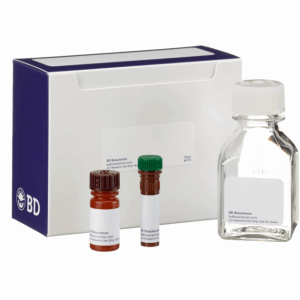
|

| 產(chǎn)地 | 美國 |
| 品牌 | BD |
| 貨號 | 556547 |
| 保存條件 | Store undiluted at 4°C and protected from prolonged exposure to light. Do not f reeze. |
| 用途 | |
| 應(yīng)用范圍 | Flow cytometry (Routinely Tested) |
| 抗原來源 | |
| CAS編號 | |
| 保質(zhì)期 | |
| 抗體名 | 無 |
| 是否單克隆 | 是 |
| 克隆性 | 是 |
| 靶點(diǎn) | |
| 適應(yīng)物種 | 無 |
| 形態(tài) | 無 |
| 宿主 | 無 |
| 標(biāo)記物 | |
| 包裝規(guī)格 | |
| 純度 | % |
| 亞型 | 無 |
| 標(biāo)識物 | 無 |
| 濃度 | % |
| 免疫原 | 無 |
| 是否進(jìn)口 | 是 |
RRID:AB_2869082
Apoptosis is a normal physiologic process which occurs during embryonic development as well as in maintenence of tissue homeostasis. The apoptotic program is characterized by certain morphologic features, including loss of plasma membrane asymmetry and attachment, condensation of the cytoplasm and nucleus, and internucleosomal cleavage of DNA. Loss of plasma membrane is one of the earliest features. In apoptotic cells, the membrane phospholipid phosphatidylse rine (PS) is translocated from the inner to the outer leaflet of the plasma membrane, thereby exposing PS to the external cellular environment. Annexin V is a 35-36 kDa Ca2+ dependent phospholipid-binding protein that has a high affinity for PS, and binds to cells with exposed PS. Annexin V may be conjugated to fluorochromes including FITC. This format retains its high affinity for PS and thus serves as a sensitive probe for flow cytometric analysis of cells that are undergoing apoptosis. Since externalization of PS occurs in the earlier stages of apoptosis, FITC Annexin V staining can identify apoptosis at an earlier stage than assays based on nuclear changes such as DNA fragmentation.
FITC Annexin V staining precedes the loss of membrane integrity which accompanies the latest stages of cell death resulting from either apoptotic or necrotic processes. Therefore, staining with FITC Annexin V is typically used in conjunction with a vital dye such as propidium iodide (PI) or 7-Amino-Actinomycin (7-AAD) to allow the investigator to identify early apoptotic cells (PI negative, FITC Annexin V positive). Viable cells with intact membranes exclude PI, wheras the membranes of dead and damaged cells are permeable to PI. For example, cells that are considered viable are FITC Annexin V and PI negative; cells that are in early apoptosis are FITC Annexin V positive and PI negative; and cells that are in late apoptosis or already dead are are both FITC Annexin V and PI positive. This assay does not distinguish between cells that have undergone apoptotic death versus those that have died as a result of a necrotic pathway because in either case, the dead cells will stain with both FITC Annexin V and PI. However, when apoptosis is measured over time, cells can be often tracked from FITC Annexin V and PI negative (viable, or no measurable apoptosis), to FITC Annexin V positive and PI negative (early apoptosis, membrane integrity is present) and finally to FITC Annexin V and PI positive (end stage apoptosis and death). The movement of cells through these three stages suggests apoptosis. In contrast, a single observation indicating that cells are both FITC Annexin V and PI positive, in of itself, reveals less information about the process by which the cells underwent their demise.